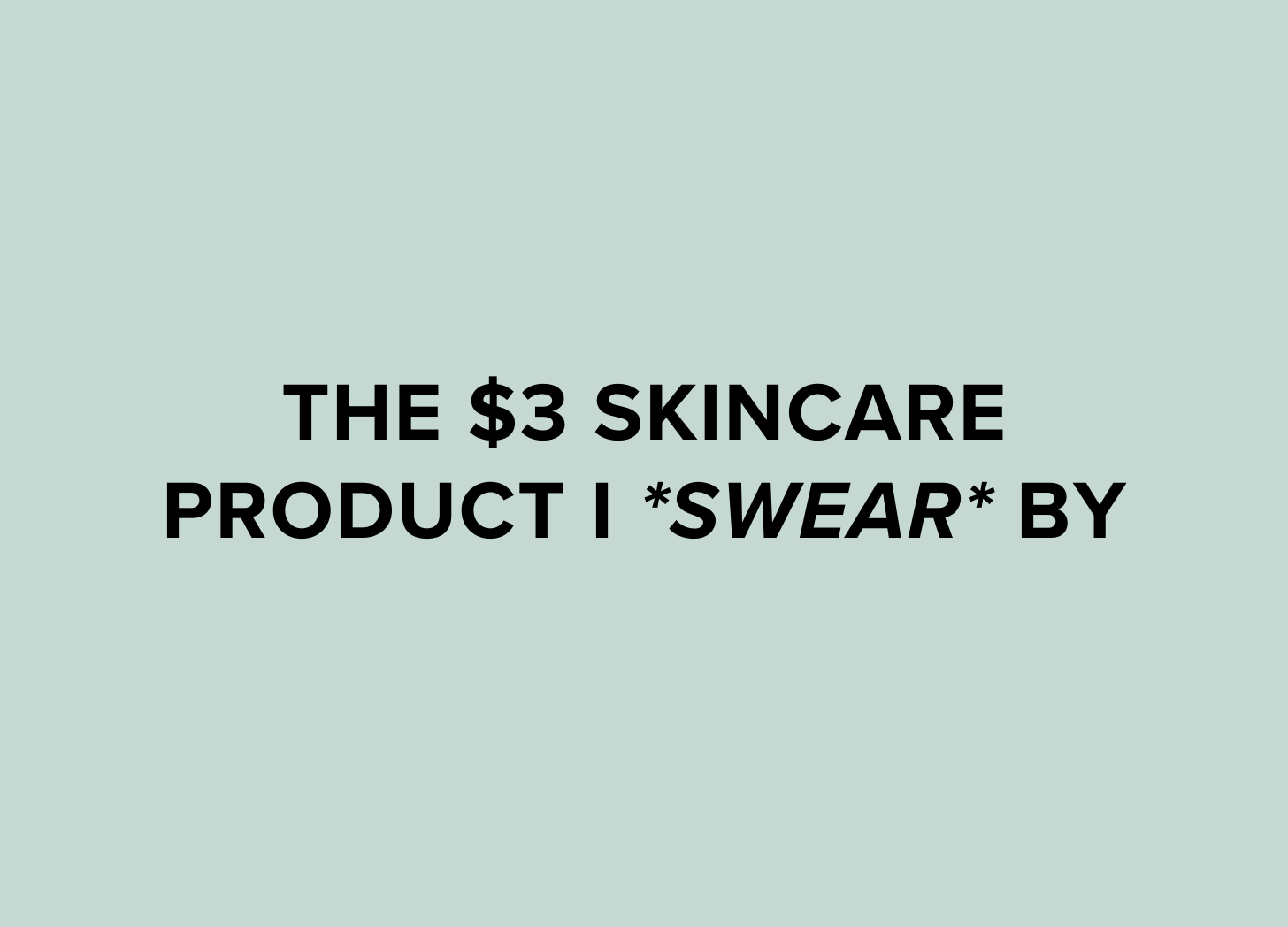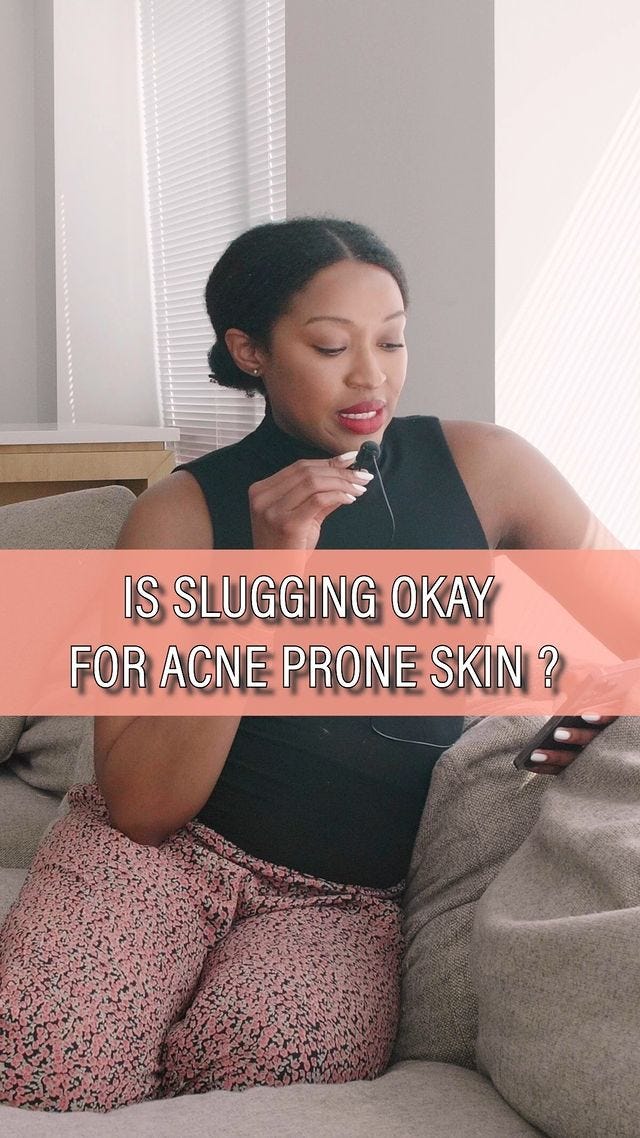The $3 Skincare Product I Swear By 🤯
You can find it in any drug store (or, heck, grocery store!) and it totally transformed my skin.
In another life (AKA, earlier in my career) I worked in the skincare industry, managing content and social media for a handful of artisanal skincare brands that were located across the US.
I loved doing this work, and getting a front row seat while so many well-formulated, beautiful, thoughtful brands came to the forefront of the industry was a ride all it’s own.
Despite spending the majority of my time steeped in the world of skincare, my proximity to so many skincare experts, and easy access to incredible products — the best skincare advice I have ever received was delivered across a table in a Panera Bread.
And it completely flipped my skincare routine upside down, blew my mind, and transformed my skin.
Not to mention — it’s by far the cheapest part of my skincare routine while also being the most impactful AND it amplifies the benefits of every other product I use. It is, you might say….my $3 holy grail.
And no — my big skincare secret is not not coconut oil or water. Although, they are both pretty vital, too. 😏
THE $3 MIRACLE PRODUCT
Let me set the scene. The year was 2015. I was out for lunch with my friend Les. She’s a Black woman and is a couple decades older than me. We often talked about skincare and to date…Les had schooled me on more than one occasion. This was when I started to wholeheartedly believe that we should basically get all of our skincare advice from Black women.
Anyways, I found myself complaining about a new face serum I had recently started using. I thought it was a good product, but hated the way it smelled.
Les stared off into the distance and responded halfheartedly with, “How can you smell the oil? All I smell is the Vaseline.”
V-A-S-E-L-I-N-E
And THAT was the day I learned that Vaseline is a powerful skincare tool that is not only recommended by the American Academy of Dermatology and raved about by celebrities and skincare gurus — but a skincare tool that has been used for thousands of years by various cultures around the globe.
Native Americans discovered petroleum jelly and used it for protecting and healing the skin. Sophisticated oil pits were built in Western Pennsylvania as early as 1415–1450 (source).
Vaseline has long been a staple in most Black households for generations, being used as a full-body moisturizer after baths and as hair pomade (source).
Even Korean Beauty, often lauded and revered in the skincare industry, has a deep connection with petroleum jelly (source).
So, although TikTok has recently tried to rebrand this age-old skincare secret as an internet trend known as “slugging”, the method of sealing your skincare products with an occlusive has a long and proven track record.
HOW IT WORKS
First things first, it’s important to understand the role Vaseline plays in a skincare routine and how to use it properly. The nitty-gritty, if ya will.
Most importantly, Vaseline should not be thought of as a moisturizer. The word “Vaseline” is a combination of the German word for water (wasser) and the Greek word for oil (oleon).
Vaseline is what the gurus would call an “occlusive”. An occlusive is an ingredient that forms a physical barrier over the skin to keep it moist and hydrated. In a nutshell, Vaseline *traps* moisture, reduces trans epidermal water loss, and lets your skin do its thing.
This can help your skin get that plump, hydrated look but can also amplify the effects of other skincare products you’re using, such as serums or oils.
HOW TO DO IT
You’ll use the Vaseline as the final step in your skincare routine, warming just a pea-size amount between your fingertips before gently smearing it across your face. All of your other products should go on first — face mist, oil, moisturizer, eye cream etc., — and then comes the Vaseline…there to create a protective barrier that will allow your skin to soak up those products and reap their benefits while you sleep.
In the morning, just wash your face with warm water (I love using warm water + a konjac sponge) to remove the Vaseline and enjoy your new, hydrated glow.
EXTRA TIPS
Since I’d love to consider myself a Slugging OG, I have some additional tips to make sure you get the most out of this.
Air dry! Do not dry your skin after you wash your face at night. Instead, let the water slowly absorb into your skin while you brush your teeth or do other things. Even better? Do that AND use a face mist and allow that to absorb, as well, before you apply any moisturizers or serums. Once all moisturizers, oils, or serums are gently pressed into your skin, you’re ready to apply a thin layer of Vaseline over the top.
Stay hydrated! And go to bed hydrated! The Vaseline can’t trap in moisture if there’s no moisture to trap, ya know? So don’t just apply lotions and oils and hope for the best. Make sure you’re hydrating yourself deeply throughout the day and going to bed hydrated.
Do your lips, too! I’ve also found that this is an incredible way to trap moisture in my lips at night. Not only does this help avoid chapped or dry lips, but it makes them look just a *bit* more plump and full the following day. Are you gonna look like you got lip filler? No. But it’s just a nice, subtle difference that I appreciate. To do it, I apply a thin layer of face oil to my lips, let it absorb, add a thick moisturizing lip balm, then top with Vaseline. And before you ask, yes “Vaseline meets FDA requirements for being safe for human consumption. (source)” While I wouldn’t spread it on a sandwich, the reality is that it’s likely safer than most of the products you put on your lips (lip balm, lipstick, lip fillers, etc), and you’ll likely “ingest” very little of while you’re sleeping…unlike that Chanel lipstick you’re wearing while you sip a latte.
SAFETY AND ENVIRONMENTAL IMPACT
You might find yourself thinking something along the lines of “Gross, isn’t petroleum jelly basically gasoline?!”
This is more or less what my initial reaction to this advice was, and I really had to hit pause and unpack this. While you might find sentiments like this online, it’s important to consider the source and lean on ones that are current and reliable.
Many of us have a negative reaction to fossil fuels and their byproducts because of the role they play in climate change. We associate them with pollution and environmental damage.
But, as the name implies, fossil fuels literally come from decomposing plants and animals. You can’t really get more “natural” than that. The problem with fossil fuels is the rate at which humans are extracting them from the ground and then burning them as a fuel source and releasing them into the atmosphere.
Products like petroleum jelly — which is what Vaseline is made from — are a byproduct of this process, and finding ways to utilize these byproducts can and should be considered sustainable and environmentally friendly.
Even products that call themselves “green” or “clean” require the use of fossil fuels in their production — to transport the raw materials, create packaging, ship them, etc. The reality is that currently no products are free of a carbon footprint, and a byproduct of crude oil production does not, necessarily, have a larger imprint than other products that market themselves as sustainable or environmentally friendly.
While petroleum products can be contaminated with a carcinogen known as PAHs (polycyclic aromatic hydrocarbons), the petroleum jelly used in brand’s like Vaseline are triple purified. So if someone tries to fear monger you about PAH contamination, all you need to do is ensure the brand you’re using meets this standard.
And while this might not be a popular thing to say out loud: it also comes down to the fact that many affordable, accessible products have been demonized unfairly — mostly by white female influencers — so that they can convince you to use their 15% off code for whatever skincare brand is offering them a commission check.
Many people seem to laud Europe as the mecca of safe skincare — so I’ll also share that Vaseline is widely available here and that yes, it has the same ingredients and safety standards as the Vaseline in the US.
A WORD OF CAUTION
Vaseline is widely known as one of the best products for sensitive skin, so although a negative reaction is rare, it’s always a good idea to do a small patch test when trying anything new on your skin. Simply put a small amount of Vaseline behind an ear overnight to see if any reaction occurs.
Since Vaseline can make your other products more potent, you’ll want to exercise caution when putting it over products like retinol, salicylic acid, or vitamin c. Personally, I put it over a vitamin c serum regularly and haven’t had any issues, but depending on the strength of your products or sensitivity of your skin, it may cause a reaction.
Using an occlusive to seal in moisture can also amplify some skin conditions, such as milia. If you have this around your eyes or other areas of your face, you may want to avoid using this method in those areas or altogether.
While most of us can benefit from using Vaseline nightly (especially as we age or if we live in dry environments), you can also get benefits by doing it just a few nights a week if it seems like too much for your skin.
LEARN MORE
If you wanna go a bit deeper on “slugging” (AKA using Vaseline) there are a couple of accounts I can recommend.
First up is Dr. Elyse Love, a board certified dermatologist and cohost of the Beauty Curious Pod. She does these great Q+A’s on Instagram that are short but very informative:
Another fav skincare expert to follow online is Charlotte Palermino, a licensed esthetician. She does a great job of breaking down the science and debunking beauty influencers. The New York Times ran a great summary of all her work covering Vaseline + slugging that you can read here. She’s also a great follow on Instagram or TikTok:
As a pretty standard disclaimer — I know that not everything I write will be for every person. If you have considered Vaseline and decided that you will not, under any circumstances, smear it on your face — I 100% support you in that. Stick to the routine you’re comfortable with and loving. But if you end up feeling like your skin is dry and that $70 serum isn’t doing what you want it to do….please give this method a whirl.








This was super informative -- thank you for sharing! I would love to know what other products you use in your skincare regimen. I've tried a few, but everything has been prettttttty expensive.
YASSSS. I was anti- petroleum jelly until the dermatologist recommended it as part of the treatment for my son’s moderate eczema. Vaseline is basically inert. And it works. I tried so many “natural” treatments for his eczema, including things like jojoba oil. But Vaseline, while not a treatment, keeps his skin mostly clear year round. So good and so inexpensive. I will have to add it to my own routine this winter (MN winters make my skin soooo dry.)